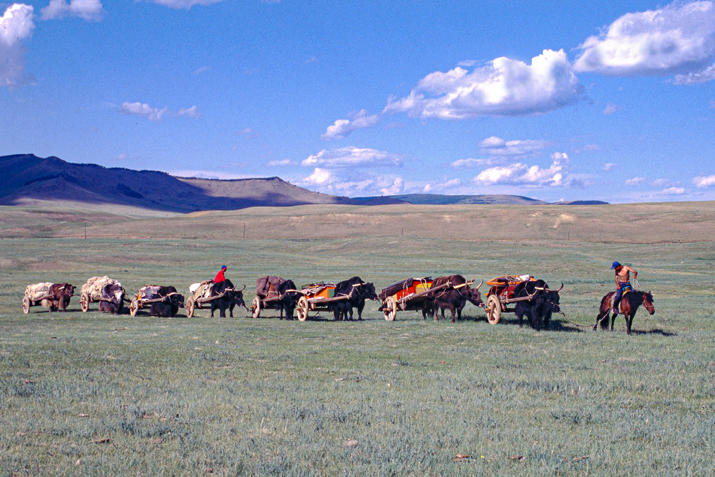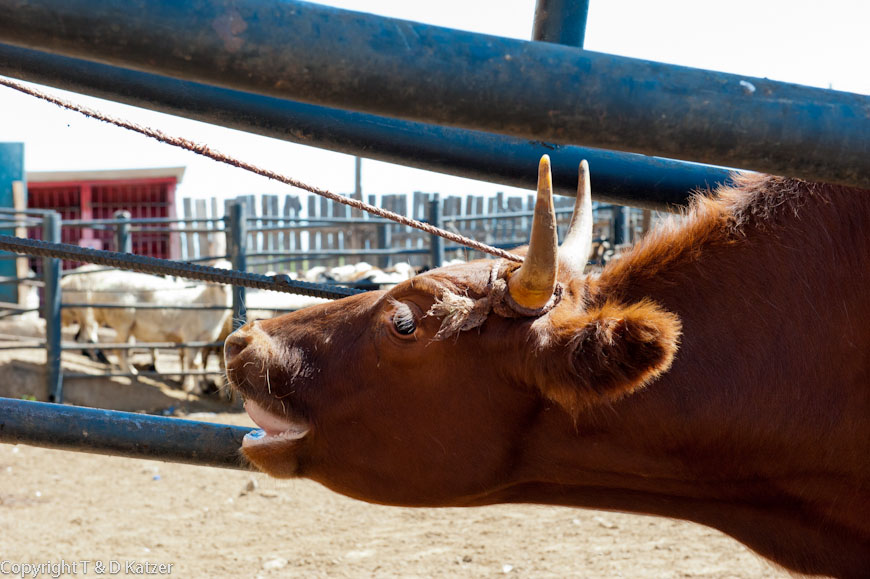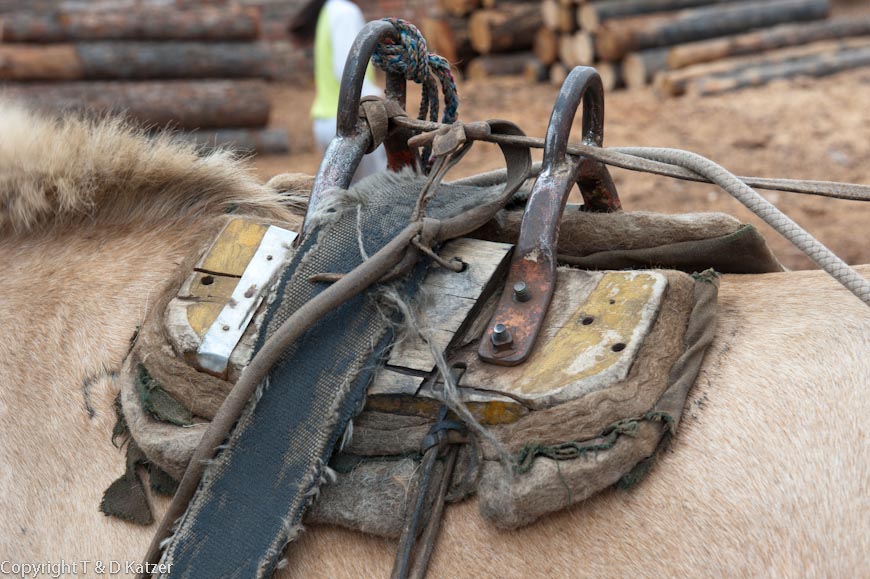
Horror in the slaughterhouse
N 49°01'802'' E 104°01'571''
Day: 18
Sunrise:
05:49 pm
Sunset:
8:28 pm
Total kilometers:
400
Temperature – Day (maximum):
31 °C
Temperature – day (minimum):
20 °C
Temperature – Night:
16 °C
Latitude:
49°01’802”
Longitude:
104°01’571”
Maximum height:
1415 m above sea level







Tsaagaan comes to our log cabin first thing in the morning. “We have chosen you,” we tell him. “Oh, thank you very much,” he replies and laughs, visibly pleased to have a paid job. “Do you really want to go on a strenuous journey with us?” I ask again to make sure that the man really wants to accompany us. “Yes, I’d love to,” he replies again. “Good, then we’re a team now,” I say and hold out my hand to him. He shakes it and sits down at the table with bread, jam and boortsog, which are meatballs cooked in batter and boortsog without meat. There is also tea and coffee. The food is sipped and slurped with relish. The louder the better it tastes, apparently. In any case, smacking and slurping are not a bad habit in Mongolia. During breakfast, Ulzii calls his older brother, who lives in Erdenet and owns a minibus. He agrees to go horse hunting with us. “All you have to do is pay for the gas. In the end, you give me what you think,” he says. We are very happy with the offer and are pleased that the family ties seem to work well here in Mongolia. A little later, the action starts. Naraa, our hostess, her 21-year-old son Erkhembayar, our companion Ulzii, our translator Taagii, Ulzii’s uncle Tsaagaan, Tanja, myself and the bus owner and Ulzii’s brother, set off in his minibus to go horse shopping. Everyone wants to be there. Our first stop is the Erdenet cattle market. We all get off the bus together in the 31° heat and walk through the dusty market. “Don’t take pictures! Or pay!” shouts a corpulent Mongolian woman unkindly. “He wants to buy horses!” Taagii answers me protectively. “I see. Well, that’s different then,” she suddenly says sweetly. “What do people do with the animals here? I mean why do shepherds buy horses, cattle and sheep here? They have enough of them themselves,” I ask. “The animals come here to be slaughtered,” explains Taagii. Only now do Tanja and I notice that one ox after the other is being led through a door into the adjoining building. Unpleasant odor penetrates to the outside. Tanja takes a look inside and calls out; “You have to see this Denis!” Before I can react, Tanja has disappeared into the dark building. Disgusted by the gruesome sight, I look after her. Slaughtered animals hang on butcher’s hooks. The smell that hits me is downright stunning. “Why are you doing this to yourself?” I call after Tanja. “You can’t avoid reality. Even if I don’t eat meat, I want to know where it comes from and how the animals fare before they die. This is where the meat on people’s plates comes from!” I hear her shout and wonder how she, as a convinced vegetarian, manages to go to such a gruesome house of suffering and death. Slowly, I also enter the interior. It smacks under my shoes with every step. Blood and excrement cover the entire ground. Women carry animal parts back and forth, sweep the caked blood aside with a brushwood broom, pull and carry intestines. I feel sick at the moment. “Do you think we can take photos?” asks Tanja. “I just take photos,” I reply, trying to control my nausea. Due to the heat and the catastrophic hygienic conditions in this slaughterhouse, which cannot be described, I feel like I am in the pit of hell. I am in the middle of the action. The bloodied, hard-working people smile at me. Two butchers drive a cow through the door. The horror and fear of death are written all over her face. Tanja has already left the scene of horror when a butcher lifts a large axe and hits the cow right between the eyes. Fatally hit, the animal immediately collapses. At the moment of death, all four legs twitch spastically. At this moment, a father passes by with his daughter, who is about seven years old. You can see the child’s shock. Her eyes widened in shock. I wonder why a father would take his child through this place. However, survival without meat is unthinkable in Mongolia. As I leave the slaughterhouse, I think about the suffering of the creatures and about the excessive consumption of meat by people on this earth. I am sure that many a citizen of the world would reflect on their eating habits if they had witnessed such a slaughterhouse. Lost in thought, I step outside again. “What do you think of this horse? It’s a beautiful animal,” Naraa’s cheerful statement brings me back to a more pleasant reality.
“Are all the horses slaughtered here too?” I ask Taagii. “Sure.” “Don’t you feel sorry for them?” “Why should I feel sorry for them? We humans have to eat meat. We can’t survive in Mongolia without meat.” “Well, Tanja and I walked 7,000 km through Australia without eating meat. You don’t need to eat animals to be able to perform. But it might be different here with you. I know it gets extremely cold here in winter and the nomads need meat as their main food to survive.” Then why are you asking if I feel sorry for you?” “It’s because of the experience I just had in that house over there. It would be nice if all humans and animals could live peacefully side by side.” “That will never happen,” says Taagii. “Who knows. Times are changing. At some point in the future, people will talk about today as if we were all cannibals. I think the time will come when we value all living beings as we value ourselves. No one will think of eating such a creature, whether bird, pig, sheep, cow or any other animal. We will, I hope, all be vegetarians. As I said, Tanja and I have proven that we have not developed any deficiency symptoms after years of top performance without meat,” I say quietly and look at the horses.
Because we called Bilgee, the horse man we had to cancel, this morning and asked him if he could imagine helping us build the horse-drawn carriage for a fee, he has now turned up too. “I’ll be happy to help you,” he says and supports us in choosing the right riding horses. A little later, we test ride one or two horses. Some are injured, not well nourished or old. Not good horses for an expedition. They are also very expensive at 480,000 tugrik (€275). Tsaagaan stands on the sidelines and doesn’t lift a finger while Bilgee takes a close look at the horses and gives us advice and support. “Why isn’t your uncle doing anything? We hired him as a horse expert. We need him right now,” I say to Ulzii. Ulzii nods and speaks to his uncle. Now he comes along, points to a horse and says: “That’s a good horse”. “Strange, the others said this horse was too old,” whispers Tanja. “Hm, everyone seems to say something different. We should rely on our feelings and take the various statements into account,” I suggest. After a while we find three horses that make quite a passable impression on us and can be ridden quite well. I try to negotiate the price but the seller won’t go down a single tugrik. “That’s just a middleman. I asked him if the horse bites or kicks and he shrugged his shoulders. I’m sure he bought the horses from the shepherds somewhere in the steppe to sell them to the butcher here at the market,” I think aloud. I ask Taagii whether my train of thought corresponds to reality, to which he nods his head in confirmation. “The horses are not expensive. That’s just the market price of the meat. They are much more expensive with the herdsmen,” the trader suddenly says as if he could read my mind. Tanja and I agree that we are looking in the wrong place. Our instinct whispers of the trader’s dishonesty and that we should try our luck with the nomads in the area. Our companions suddenly all agree. “Are you coming with me?” I ask Bilgee. “I won’t be accompanying you and I’ve decided not to help you build the horse-drawn wagon either. You have enough people now. But if you need my help, I’ll be happy to come,” he replies, to which Tanja and I are disappointed, as we had asked for his help. “Someone should be smart about it,” I say to Tanja and shake Bilgee’s hand goodbye. Before we turn our backs on the pet market, we let the dealer know that we have until 11:00 a.m. tomorrow to make a purchase decision. “Please tell him not to take the animals to the slaughterhouse until then,” I ask Taagii to translate. “He agrees,” replies Taagii. “If he gets the same price from the butcher as from us, why does he want to wait for us?” I ask. “I have no idea. He’s probably lying,” replies our 26-year-old translator.
Horses from the haulage company
Minutes later, we have squeezed back into the minibus. There are now ten of us. Someone from the market wanted a lift with us. I shrug my shoulders. “It will all make sense,” I think to myself. Ulyti’s uncle, who has great difficulty finding the right gears, jerks his vehicle through the dusty, heat-stricken Erdenet. We stop at a haulage company. Not as we know it in Europe, but at a Mongolian timber transportation company. Here, trimmed tree trunks and firewood are transported to customers by horse and cart. “What do we want here?” asks Tanja, “You need a horse and cart and suitable draught animals. We’ll just ask these people if they’ll sell you one of their three wagons. If you’re lucky, you’ll also get the horse,” translates Taagii. “What do you mean?” I ask. “Because it’s not easy to get good draught horses,” I hear. Excitedly, we walk to the logging company. The men are actually willing to sell one of their badly dilapidated horse-drawn carts and a horse. “Great,” we say happily. How much is the old thing supposed to cost?” we ask. “800,000 Tugrik”, (457,- € or 666,- US$) says the owner. Considering that the average income is around US$150 a month, that’s a huge sum. “What does he want for the horse and cart?” “He’s only selling it with the horse,” we hear. “Of course, the man smells a good deal,” Tanja interjects. Nevertheless, we are interested in the deal. As we negotiate with the haulier, a small woman from the wagoners surprisingly offers us her draught horse as well. Suddenly, our negotiations revolve around two draught horses and a horse-drawn cart. They want a total of 1.3 million tuggrik (€743). We examine the horse for injuries and discover a swollen vertebra. “No problem. That’s an old injury that has already healed. You see,” says the little woman and presses the affected area on her horse. In fact, the animal shows no reaction. “Apparently she’s telling the truth,” I say, taking a closer look at the vertebra. “The injury comes from a saddle from the time when my horse was still being used as a mount. The harness is resting on a completely different spot,” she says, pointing to the battered steel frame over which a wide strap runs that is attached to the left and right of the drawbars. Underneath the steel and wooden frame is a used felt pad that doesn’t seem to be responsible for the injury. Although we are still not entirely convinced how old the injury is and despite the fact that the two sellers have not reduced their price by a tugrik despite long negotiations, we are forced to agree to their demands. Who would have thought of getting well-trained draught horses and a horse-drawn cart so quickly? “We’ll meet again tomorrow. Then you will receive 300,000 Tugrik as a down payment. From then on, the horses are no longer allowed to work,” I decide and ask the boss of the small carting company to take the cart to a carpenter of our choice tomorrow so that we can have it rebuilt there. Then we say goodbye to the people and decide to continue our search for horses in the surrounding steppe landscape.
Yurt visit
“I have very good horses for you,” a Mongolian offers us on the way to the minibus. “How far is that from here?” I want to know. “Not far. Only three kilometers. “Okay, let’s go and have a look at your horses,” I reply, and we all get on the bus and leave Erdenet. After half an hour’s drive, we are still not at the yurt camp. “That’s a long three kilometers,” Tanja turns to the nomad. “If we had taken the shortcut, it would only be three kilometers, but it’s longer on the road,” he justifies himself in a friendly manner. Then we leave the main road, which has only been paved for a few years, and drive across the wide meadows. We pass various yurts, herds of horses, sheep and goats and then head towards a solitary yurt. The man points to a horse in the middle of a large herd. “Well, that won’t do us much good. We need to see the horse up close and ride it,” I say to Taagii. It doesn’t take long before one of the nomads swings himself onto his horse with a three-meter-long stick with a noose at the end and chases after the herd. A little later, the shepherd has put the noose around the horse’s neck at full gallop, which he wants to catch for us. It rises up on its hind legs and really rears up. “But it doesn’t look like a tame riding horse,” says Tanja. “Hm, not really our horse,” I agree with her. “No problem. The horse hasn’t been ridden for a year. After a few days it’s totally tame,” the nomad justifies his animal’s wild behavior and grabs the horse between its hind legs to prove it. He laughs quite heartily.
Because it has started to rain, we are invited into the yurt. Following the traditional seating arrangement, we are offered seats to the left of the entrance. The seats of honor are located opposite the entrance. Servants and the poor sit on the right-hand side next to the door, then come the women, grandparents, respected guests and children. Even though seating arrangements are no longer taken so strictly these days, most nomads still adhere to these rules.
The man who has just caught the horse opens a large bottle of beer and pours a cupful. Then he gives the cup to the first guest. In accordance with Mongolian politeness, he simply sips from the vessel and hands it back to his host. He takes a big sip, fills it again and gives it to the next guest. He just sips it again and hands it back. The man of the house takes another sip, fills the glass and hands it to the next guest. After a while, the cup reaches Tanja and me. For hygienic reasons alone, Tanja and I also only pretend to drink from the fine brew and return the full container to its owner. Now the whole thing starts all over again. After I’ve returned the goblet a second time, you can see the effects of the alcohol on our host. Now that he has had a warm drink, he fetches a bottle of vodka to repeat the drinking session. “We should go,” Tanja whispers to me because the man gets uncomfortably loud after the second glass of vodka. “Bajarlaa, Bajartai!” (“Thank you, goodbye”), we say goodbye. “Stay a while”, says the master of the house as we have already left the yurt. “If we haven’t found suitable horses by tomorrow, we’ll come back,” I say, then we get back into the minibus to take the shortcut to Erdenet this time. The bus works its way at walking pace over grass hubs, rutted lanes and troughs. Even if the route is indeed shorter now, we would be faster on the asphalt road. Ulzii’s brother drops us off in front of Naraa’s log cabin. I give him the agreed fuel costs plus an extra 10,000 Tugrik (€5.71). Although this is far above the average income, I have the feeling that the man is not satisfied. “Is that all right with you?” I ask. “Yes, that’s fine,” he replies and drives off. Naraa cooked for us all again. So that she didn’t have any expenses, we went shopping for the whole team at the supermarket on the way home. Naraa is happy about the many products and the company. “It’s nice to have guests. My husband left me a few years ago. Now I live here with my daughter and son. I feel quite lonely when they are not at home. It’s really a pleasure to have you here,” she says with a smile.
After lively discussions about the interesting and successful day, we retire to our sleeping mats. The full moon casts its light into the room and seems to cause the dogs in the area to bark like mad at their enemies. It takes me hours to close one eye.
We look forward to your comments!

